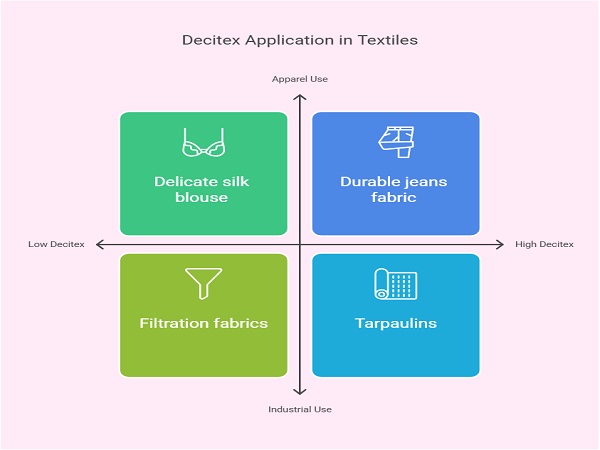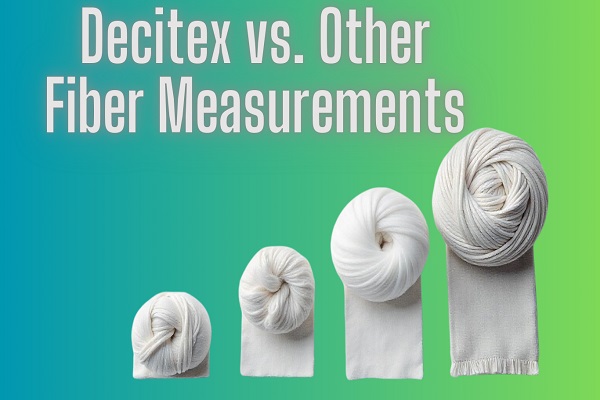Decitex (dtex) Calculator
© Yarn Count Ltd. All rights reserved.
Disclaimer: All Tools in the Yarn Count have been reviewed by the relevant spinning industry experts.
The formula for calculating Decitex (dtex)
Decitex (dtex) = (Mass (g) ÷ Length (m) )×10,000
Where:
- Mass (g) = Mass of the fiber in grams
- Length (m) = Length of the fiber in meters
- Decitex (dtex) = Mass of 10,000 meters of the fiber in grams
Table of Contents
What is Decitex (dtex)?
Decitex (dtex) is a standard measurement for fiber thickness. It indicates the weight, in grams, of 10,000 meters of fiber. For example, if 10,000 meters of a fiber weigh 50 grams, the fiber's decitex is 50 dtex.

Why is Decitex Important in Textiles?
Decitex helps manufacturers, designers, and textile engineers determine fiber properties like thickness, softness, and strength. It directly affects product quality and performance in applications like clothing, upholstery, and industrial textiles.
- Thicker fibers (high dtex): More durable and insulating.
- Thinner fibers (low dtex): Lighter, smoother, and softer.
How is Decitex Calculated?
The formula to calculate decitex is straightforward:
dtex = (Weight in grams / Length in meters) x 10,000
Example Calculation:
If a fiber weighs 4 grams and measures 800 meters, the calculation is:
dtex = (4 / 800) x 10,000 = 50 dtex
This means the fiber has a decitex of 50, indicating moderate thickness.
Applications of Decitex in Textiles
1. Apparel Industry
Decitex determines fabric weight and texture for garments:
- Light fibers (5-20 dtex): Used for delicate fabrics like silk and nylon stockings.
- Medium fibers (20-50 dtex): Applied in everyday clothing like shirts and dresses.
- Heavy fibers (50+ dtex): Used in durable garments like jeans and jackets.
2. Home Textiles
- Light fibers: Curtains and bed linens.
- Medium fibers: Upholstery and cushion covers.
- Heavy fibers: Carpets and mats.
3. Industrial Textiles
- Low dtex fibers: Used in filtration fabrics.
- High dtex fibers: Applied in tarpaulins and seat belts.
Decitex vs. Other Fiber Measurements

1. Decitex vs. Denier
- Decitex: Grams per 10,000 meters.
- Denier: Grams per 9,000 meters.
To convert denier to decitex:
- dtex = denier x 1.111
2. Decitex vs. Tex
- Decitex: Grams per 10,000 meters.
- Tex: Grams per 1,000 meters.
To convert tex to decitex:
- dtex = tex x 10
Factors Affecting Decitex
Several factors influence fiber thickness and mass:
- Material Type: Natural fibers like cotton differ from synthetic fibers like polyester.
- Production Method: Spinning and extrusion processes impact fiber mass.
- Moisture Content: Fibers absorb moisture differently, affecting weight.
How to Measure Decitex Accurately
- Prepare the Sample: Cut a 10,000-meter sample.
- Weigh the Sample: Use a precision scale.
- Apply the Formula: Calculate decitex using the standard formula.
Practical Tips for Textile Engineers
- Use Consistent Measurement Tools: Precision scales prevent errors.
- Account for Moisture: Dry fibers before measuring.
- Verify Supplier Data: Cross-check reported dtex values.
Frequently Asked Questions
1. What is a high decitex value?
A decitex above 50 is considered high, indicating thicker, heavier fibers.
2. Why is decitex important for synthetic fibers?
It helps standardize fiber quality across different production batches.
3. How does decitex affect fabric feel?
Higher decitex values result in rougher textures, while lower values create smoother surfaces.
Conclusion
Decitex (dtex) is essential for measuring fiber mass and optimizing textile quality. Textile engineers rely on decitex to select fibers that match product requirements, ensuring durability, comfort, and performance across various applications.